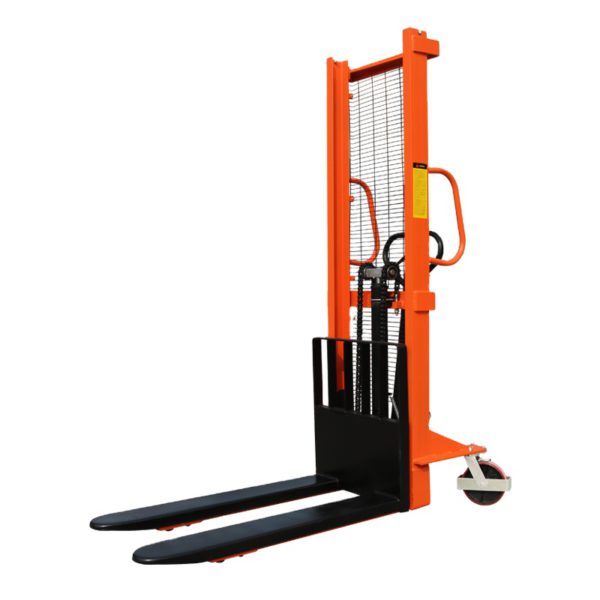What are some common safety guidelines for operating a hydraulic hand forklift?
Operating a hydraulic hand forklift safely is essential to prevent accidents, injuries, and damage to goods or equipment.
Here are some common safety guidelines to follow when using a hydraulic hand forklift:
- Training and Certification:
- Ensure that operators receive proper training on the safe operation of a hydraulic hand forklift. This includes understanding the controls, load capacity, stability principles, and safe operating procedures.
- Operators should be certified or authorized to operate the equipment, demonstrating their knowledge and competency in handling the pallet jack.
- Pre-Operational Inspection:
- Conduct a pre-operational inspection of the hydraulic hand forklift before each use. Check for any visible damage, loose or worn parts, hydraulic leaks, or other potential hazards.
- Ensure that the forks are in good condition, free from cracks or bends, and properly positioned.
- Load Capacity and Stability:
- Be aware of the load capacity of the hydraulic hand forklift. Do not exceed the maximum load capacity specified by the manufacturer.
- Ensure that the load is evenly distributed on the forks and properly secured to prevent shifting during transport.
- Avoid overloading or unbalanced loads, as they can affect the stability of the pallet jack.
- Maneuvering and Operation:
- Operate the hydraulic hand forklift at a controlled speed, especially when turning or maneuvering in narrow spaces.
- Use caution when moving on uneven surfaces, ramps, or inclines.
- Maintain clear visibility by keeping the load at a safe height that does not obstruct the operator’s view.
- Personal Protective Equipment (PPE):
- Wear appropriate personal protective equipment, such as safety shoes, gloves, and, if applicable, a high-visibility vest or helmet, to protect against potential hazards.
- Communication and Pedestrian Safety:
- Communicate and establish clear signals with other workers or pedestrians in the area to ensure their safety.
- Be aware of your surroundings and watch for pedestrians, hydraulic hand forklift obstacles, or hazards. Yield the right of way when necessary.
- Parking and Storage:
- Park the hydraulic hand forklift in designated areas when not in use. Ensure that it is stable, with the forks lowered to the ground.
- Store the pallet jack in a secure location to prevent unauthorized access or tampering.
Remember, these guidelines serve as general safety recommendations, and it’s important to consult the specific safety guidelines and instructions provided by the manufacturer of the hydraulic hand forklift you are using.
What are some specific safe operating procedures for a hydraulic hand forklift?
When operating a hydraulic hand forklift, it’s crucial to follow specific safe operating procedures to ensure the safety of the operator, other personnel, and the surrounding environment.
Here are some specific safe operating procedures for a hydraulic hand forklift:
- Before Operation:
- Conduct a pre-operational inspection of the hydraulic hand forklift, checking for any visible damage, worn parts, or hydraulic leaks. Report any issues to the appropriate personnel for maintenance or repairs.
- Ensure that the load capacity of the forklift is suitable for the intended load. Do not exceed the maximum load capacity specified by the manufacturer.
- Check the forks for proper positioning and ensure they are in good condition, free from cracks or bends.
- Load Handling and Stability:
- Position the hydraulic hand forklift squarely in front of the load, aligning the forks with the pallet.
- Ensure that the load is stable and evenly distributed on the forks. Use additional securing measures like straps or bands if necessary.
- Make sure the load is within the length and width capacity of the forks, preventing overhang that could compromise stability.
- Tilt the forks slightly backward before inserting them fully into the pallet, ensuring proper engagement.
- Maneuvering and Operation:
- Operate the hydraulic hand forklift at a controlled speed, especially when turning or maneuvering in narrow spaces.
- Use the hydraulic controls to raise the load only to the necessary height for transportation. Avoid lifting the load too high, as it can affect stability.
- Maintain clear visibility of the pathway by keeping the load at a safe height that does not obstruct the operator’s view.
- When traveling, push the hydraulic hand forklift rather than pulling it to maintain better control and stability.
- Communication and Pedestrian Safety:
- Establish clear communication and signals with other workers or pedestrians in the area. Use horns, whistles, or verbal cues to indicate your presence and intentions.
- Be cautious when operating near pedestrians or other equipment. Yield the right of way and maintain a safe distance from other individuals or objects.
- Avoid sudden maneuvers or unexpected stops that could catch others off guard.
- Parking and Storage:
- Park the hydraulic hand forklift in a designated area when not in use. Ensure that it is stable, with the forks lowered to the ground.
- Engage the parking brake, if available, to prevent unintended movement.
- Store the pallet jack in a secure location, away from foot traffic or potential hazards.
Remember, these procedures are general guidelines, and it’s essential to consult the specific operating instructions and safety guidelines provided by the manufacturer of the hydraulic hand forklift you are using. Following these procedures, along with proper training and vigilance, will help ensure safe and efficient operation of the equipment.
